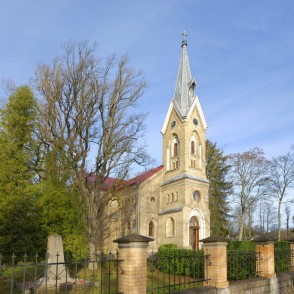18 A. Upīša Street. The church was built in 1897 in the Neo-Gothic style (Architect H. Shel) and it is one of the few19th century city brick buildings. In the church there is the altarpiece "Christ healing the sick" - I. Zeberliņš (1943). You can see the church from the inside during the worship or by a prior arrangement. Near the church, you can see a monument designed by E. Laube (1926) to 80 Latvian riflemen who died in World War I and who were buried in the Warrior's Cemetery near the river Vēršupīte. Near the cemetery, there are also buried J. Kārkliņš and F. Siliņš, fighters of the Kauguri Battle of May 18, 1919. By a prior arrangement, tourist groups can see the church from the inside.
www.celotajs.lv
Ķemeri Evangelical Lutheran Church was the first stone building in Ķemeri resort in 1897. The idea about construction of the church had appeared already earlier. But the Russian Tsar permitted the construction of the Lutheran church only in 1895; before that - in 1891 - the request regarding construction of the Lutheran church was denied because there was no Orthodox church in Ķemeri. In 1893, St Peter Paul Orthodox Church was built from timber. St John Baptist Catholic Church consecrated in 1898 was also built from timber.
The church was built according to the design by the engineer Heinrich Schel. Construction was managed by Head of the Ķemeri sulphide springs institution Dr F. fon Berg and R. Polmanis. Under their care the structure was finished in 1898. The construction of church cost 17,000 roubles.
Ķemeri Evangelical Lutheran Church was consecrated on 2 June 1897 (according to old style). The Ķemeri parish members at the time belonged to the Sloka church because the church was open only in summer during the resort season.
During the World War I, Ķemeri were in the battle zone; in 1915, the retreating Russian army burned Ķemeri, blew up the treatment institution. It is thought that during World War I the first alter painting "Christ Blesses" by Rudolf fon cur Mehlen was lost or destroyed. Afterwards instead of the altar painting a white cross was painted on a navy blue background.
During the World War II the church also suffered; it was damaged by three bombs (the traces of shrapnels could be seen on the floor of the church, in the altar space and on the tower).
Eighty Latvian riflemen fallen in World War I were buried in the Ķemeri church yard (along the left side of the church; as stated by the monument erected on 14 September 1924).
Later some soldiers of Captain Zolts fallen during the freedom battles of May 1919 were buried on the other side of the church.
www.visitjurmala.lv




